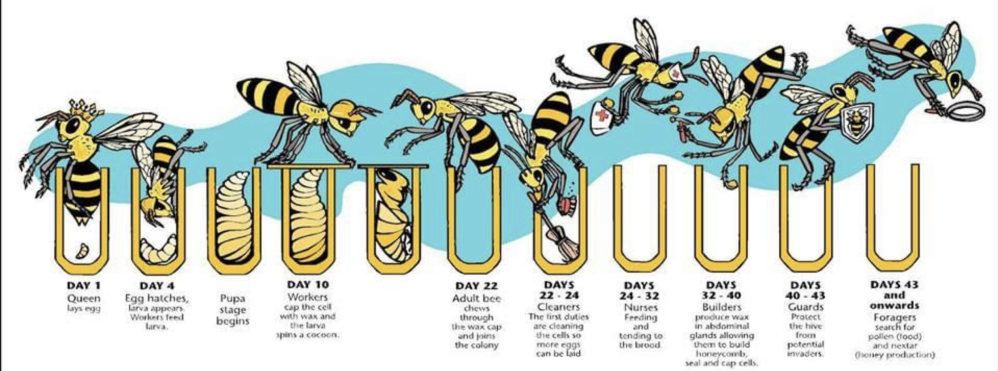This is how it all begins: The fascinating journey of a honeybee’s life starts with a single egg. Each stage has its unique characteristics and importance, helping these tiny creatures build their crucial role in our ecosystem.
At the very start, the queen bee lays an egg in a brood cell of the hive. It’s a tiny, rice-like spot that holds incredible potential. Over the next few days, this egg will transform into a larva, beginning the honeybee’s life cycle.
Understanding the entire life cycle of a honeybee – from egg to larva, pupa, and finally adult – gives insight into how these insects become vital pollinators. Each role within the hive, from worker bees to drones and the queen, contributes to the survival and efficiency of the colony.
Honeybees are more than just honey producers. They’re key players in pollinating crops, contributing to food production and biodiversity. That’s why knowing about their life cycle isn’t just an interesting fact – it’s a reminder of their importance in our world.
The Egg Stage: The Genesis of Life
The journey of a honeybee starts with the queen bee. She’s the mother of every bee in the hive, and her job is to lay eggs. Picture her moving across the comb, placing one tiny egg in each cell. These eggs are like little grains of rice, and they’re each packed with potential.
Each egg has 72 hours to hatch into a larva. During this time, the temperature and humidity in the hive need to be just right. Worker bees fan their wings to regulate these conditions, ensuring the eggs have the best chance to develop.
Not every egg is destined to become a worker bee. If the queen mates with multiple drones, the fertilized eggs will grow into workers or queens. Unfertilized eggs? They become drones. This genetic lottery determines each bee’s future role in the hive.
The egg stage might seem straightforward, but it sets the foundation for the entire colony’s organization and productivity. A healthy queen means healthy eggs, which means a thriving hive.
Remember, the egg stage is about potential. It’s a delicate phase that requires the precise cooperation of the queen and her worker bees. Without this coordination, the hive’s future would be at risk.
From Larva to Pupa: Transformation Underway
Once the egg hatches, it reveals a tiny, white larva. This stage is all about growth. Young larvae are fed royal jelly for the first few days, an ultra-nutritious substance produced by worker bees. This ensures an explosive growth rate, as the larva molts its skin multiple times to accommodate its expanding body.
After a few days, the diet changes. Worker bees start feeding the larvae a mixture of pollen and honey, often called bee bread. This is where the differentiation kicks in. If the larva is destined to become a queen, it continues to receive royal jelly. Otherwise, bee bread it is.
A critical aspect during the larva stage is care. The worker bees are like diligent nurses, constantly monitoring and feeding the larvae. They ensure each larva is well-nourished and positioned correctly in its cell to facilitate an ideal growth environment. This meticulous care is key to developing strong, healthy bees.
As the larva matures, it enters the prepupal phase. It spins a cocoon around itself, marking the transition to the pupal stage. This is when the real magic happens. Inside the cocoon, the larva undergoes metamorphosis, gradually transforming into its adult form over approximately 10 to 14 days.
During this period, worker bees seal the cell with a wax cap, protecting the pupa as it transforms. The hive’s stability and security become paramount. A disruption at this stage could spell disaster for the developing bee.
Understanding the larva and pupa stages highlights the hive’s complexity and the coordination required for successful development. Worker bees play a crucial role, ensuring that each bee has the best start.
Emergence of the Adult Bee: The Final Stage
The transformation is complete. The wax cap over the cell is removed either by the emerging bee or a fellow worker. The adult bee, regardless of whether it’s a worker, drone, or queen, inches its way out and takes a moment to breathe in its new world.
Worker bees have various duties that change as they age. Young workers begin with tasks inside the hive, like cleaning cells and feeding larvae. As they age, they graduate to foraging for nectar and pollen. This division of labor keeps the hive running smoothly.
Drones, on the other hand, have a simpler life. Their primary role is to mate with a queen from another hive. After mating, they usually die, having fulfilled their one purpose. While they don’t contribute to foraging or hive maintenance, they are crucial for genetic diversity.
Queens have a unique role. A newly emerged queen’s first task is often to eliminate rival queens in the hive. Once she establishes dominance, she mates with several drones during a mating flight. After this, she returns to the hive to begin her lifelong task of laying eggs, sometimes up to 2,000 a day.
The life span of a bee varies. Worker bees live for a few weeks during the busy summer months but can survive several months during winter. Queens, however, can live up to several years. Every bee’s efforts, regardless of its lifespan, contribute to the hive’s overall success.
Honeybees, in their different roles, collectively support the hive and by extension, the environment. Understanding this last stage emphasizes how every bee, regardless of its role, is vital to the survival and efficiency of the colony.
If you would like to receive the monthly newsletter from Beewhisperer360 drop your email address in the comments section.
